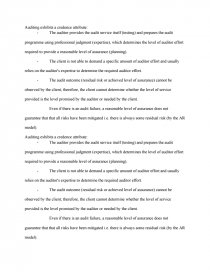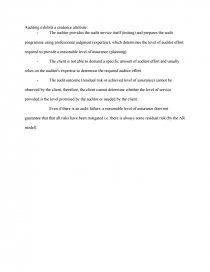Auditing Exhibits a Credence Attribute
Essay by hardout • October 25, 2012 • Essay • 394 Words (2 Pages) • 1,439 Views
Auditing exhibits a credence attribute:
- The auditor provides the audit service itself (testing) and prepares the audit programme using professional judgment (expertise), which determines the level of auditor effort required to provide a reasonable level of assurance (planning).
- The client is not able to demand a specific amount of auditor effort and usually relies on the auditor's expertise to determine the required auditor effort.
- The audit outcome (residual risk or achieved level of assurance) cannot be observed by the client; therefore, the client cannot determine whether the level of service provided is the level promised by the auditor or needed by the client.
Even if there is an audit failure, a reasonable level of assurance does not guarantee that that all risks have been mitigated i.e. there is always some residual risk (by the AR model).
Auditing exhibits a credence attribute:
- The auditor provides the audit service itself (testing) and prepares the audit programme using professional judgment (expertise), which determines the level of auditor effort required to provide a reasonable level of assurance (planning).
- The client is not able to demand a specific amount of auditor effort and usually relies on the auditor's expertise to determine the required auditor effort.
- The audit outcome (residual risk or achieved level of assurance) cannot be observed by the client; therefore, the client cannot determine whether the level of service provided is the level promised by the auditor or needed by the client.
Even if there is an audit failure, a reasonable level of assurance does not guarantee that that all risks have been mitigated i.e. there is always some residual risk (by the AR model).
Auditing exhibits a credence attribute:
- The auditor provides the audit service itself (testing) and prepares the audit programme using professional judgment (expertise), which determines the level of auditor effort required to provide a reasonable level of assurance (planning).
- The client is not able to demand a specific amount of auditor effort and usually relies on the auditor's expertise to determine the required auditor effort.
- The audit outcome (residual risk or achieved level of assurance) cannot be observed by the client; therefore, the client cannot determine whether the level of service provided is the level promised by the auditor or needed by the client.
Even if there is an audit failure, a reasonable level of assurance does not guarantee that that all risks have been mitigated i.e. there is always some residual risk (by the AR model).
...
...

